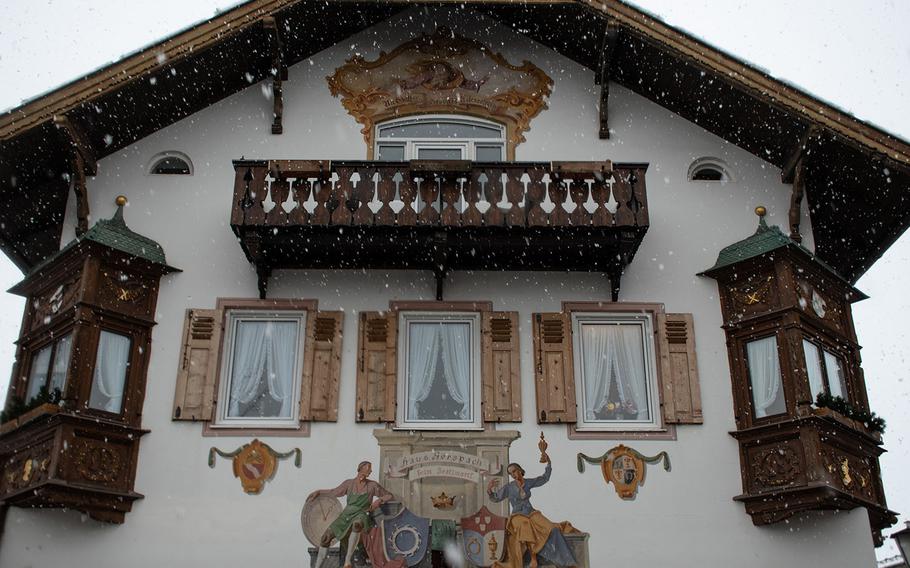
The facade of Haus Gerspach in Garmisch-Partenkirchen’s city center -- photographed during a snowfall -- shows an example of the “Lüftlmalerei” mural art found in rural areas in Bavaria. (iStock)
Continuing efforts to beat back the virus mean we’re implored to stay home for a good while yet. Despite the ongoing closure of museums and cancellation of fests, many of these outings or activities in or near cities with U.S. military installations should still be possible. Be sure to check your local command’s regulations currently in force before traveling any significant distance for recreational purposes.
Mons, BelgiumMons is the provincial capital of the Borinage, an area of the Walloon province of Hainaut. From the early 18th century, the economy of the Borinage was heavily based on coal mining. From 1878–1880, Vincent van Gogh, at the time a preacher, lived among and ministered to the area’s impoverished population. Van Gogh turned to painting soon after, and his 1885 masterpiece The Potato Eaters was inspired at least in part by the deplorable conditions he witnessed first-hand there.
A driving tour of the Borinage can take one past a handful of sites connected with the time van Gogh spent here. In December in 1878, he came to the village of Wasmes to begin a six month internship as an evangelist. A plaque on a restored house attests to his former place of residence. When his term ended, he moved to nearby Cuesmes. The visitor reception center at the Maison du Marais sheds light on how the region influenced his life and a reconstruction of a miner’s modest home. The coal mine of Marcasse, which stands on private property, can be visited upon request. A letter van Gogh wrote to his brother Theo tells of how he descended 700 meters deep into the mine and the sinister and funereal conditions he witnessed first-hand there. Online: vangoghroute.com
Catania, SicilySaint Agatha was born in Sicily around 231 and martyred some 20 years later. She is the patron saint of Catania, which is also the site of her burial. The city celebrates a major religious festival, the Festa di Sant’Agata, in her honor from Feb. 3-5 each year. With public celebrations tamped down this year, this could be the time to visit local bakeries and sample the two sweet treats made in her honor.
Cassatelle di Sant’Agata, also called Minni di Sant’Agata, are sponge cakes filled with ricotta cream, chocolate chips and candied fruit, covered with almond paste and white royal icing and a candied cherry on top. Their hemispherical shape alludes to how Saint Agatha’s breasts were torn off by order of the Roman governor Quinziano following her refusal to marry him. Olivette, or small olives, are prepared with almond paste which has been colored green and flavored with liqueur. These recall the miraculous appearance of an olive tree which provided Saint Agatha with food and shelter as she fled the governor’s men.
Garmisch-Partenkirchen, GermanyA visitor to one of Germany’s premiere resort mountain towns can’t help but be impressed by the large murals gracing the facades of old and contemporary buildings alike. The paintings represent a genre of art known as Lüftlmalerei, a form of fresco painting in the trompe-l'œil style that traces back to the Baroque. Its subject matter includes stories from the Bible and folk art depicting scenes of everyday life from hunting to gathering crops. Banners, cartouches and sundials are other common features. Lüftlmalerei is most prevalent in Upper Bavaria in Germany and the Tyrol in Austria.
Although the examples of Lüftlmalerei seen in Mittenwald and Oberammergau tend to be much older, those of Garmisch-Partenkirchen are interesting in their own right. Many date back to a post-World War II building boom and represent a renewed interest in local history coupled with an awareness of their appeal to tourists. Although many keep to the themes of old, almost all provide clues as to the property owner’s interests, hobbies and profession.
The ambitious lueftlmalerei.com website serves as a street-by-street guide to the frescoes and facade paintings in the town. The site’s American creator has catalogued 736 such works on 316 streets and posted 2,448 photos on the website to date. Information about the artist and the symbolism behind the painting’s subject matter make this a fascinating companion for exploration of the town.
Kaiserslautern, GermanyTo get a feel for the size of the vast Palatinate forest to the south of the city, a climb to the top of the Humbergturm, or Humberg Tower, is in order. Named for the hill upon which it stands, work upon the handsome 117 foot high sandstone structure was completed in 1900. Its observation platform is accessed by ascending 162 steps, most of which are housed in an interior spiral staircase. Upon reaching the top, a brass panel points out the landmarks in the distance.
There are many ways to summit the 1,400-foot-high hill upon which it stands. The shortest option is to park at Bremerhof, from which a mile-long hike leads to the tower. The symbol marking the trail is a red tower against a white backdrop. Online: tinyurl.com/yxla383n